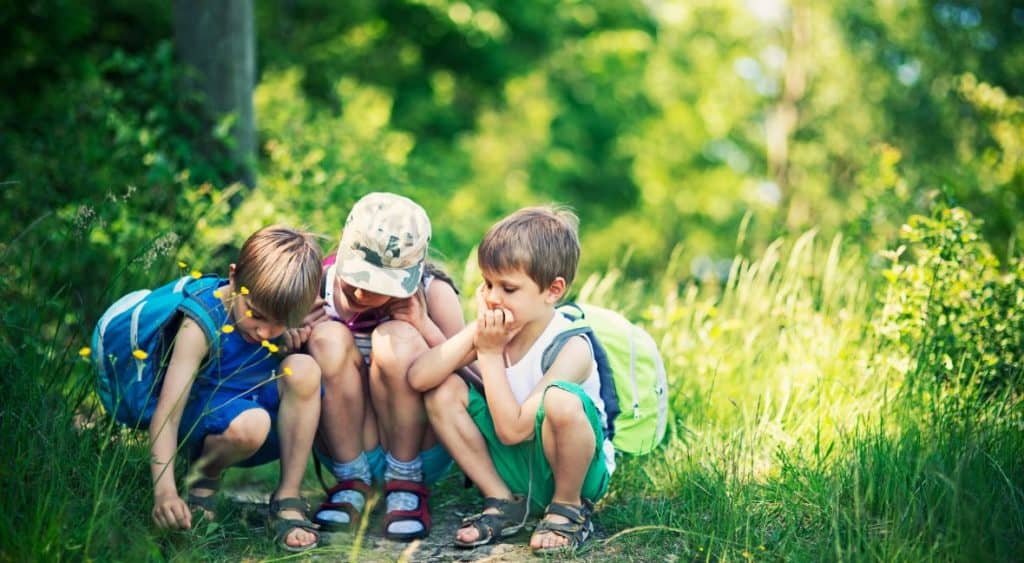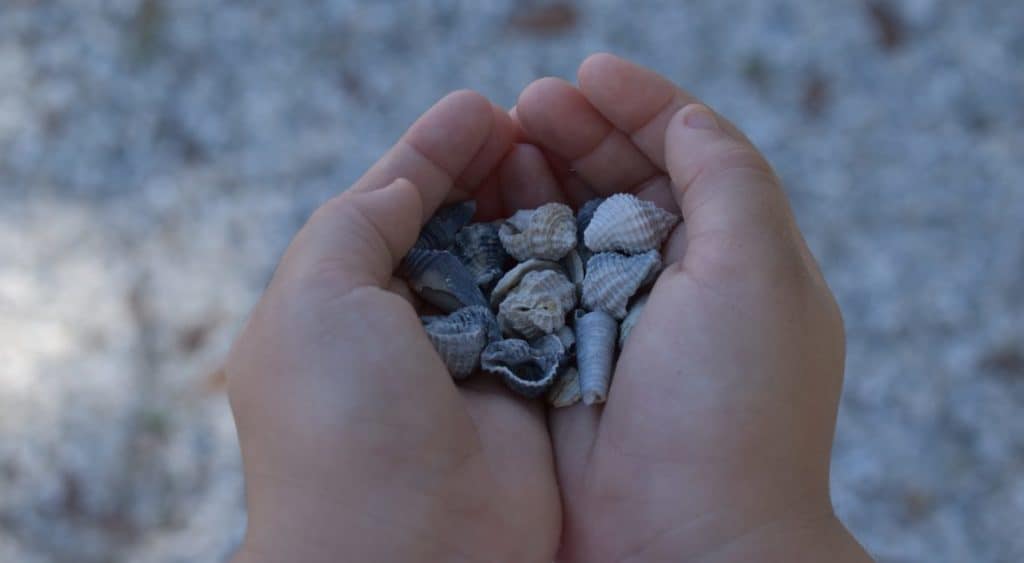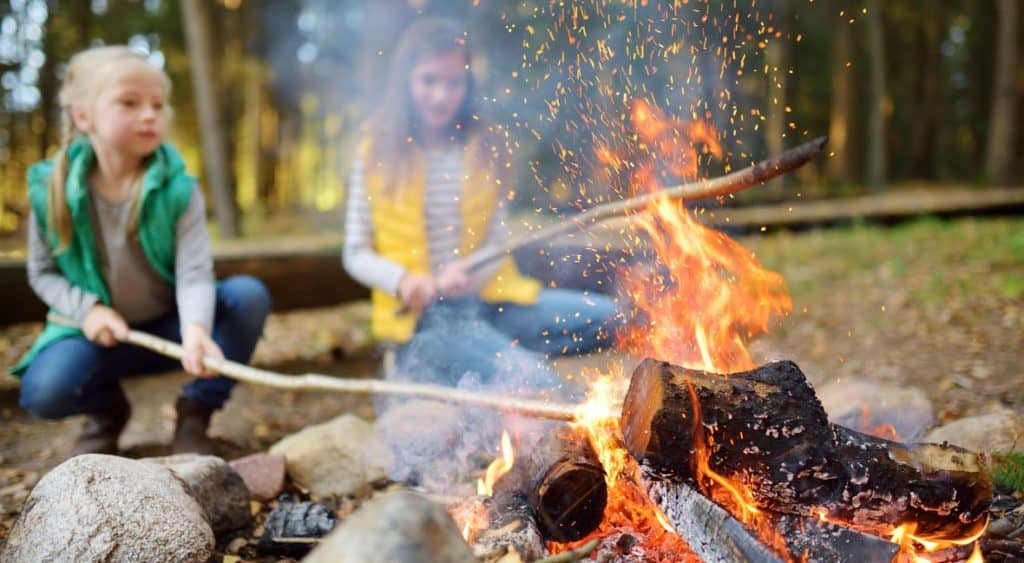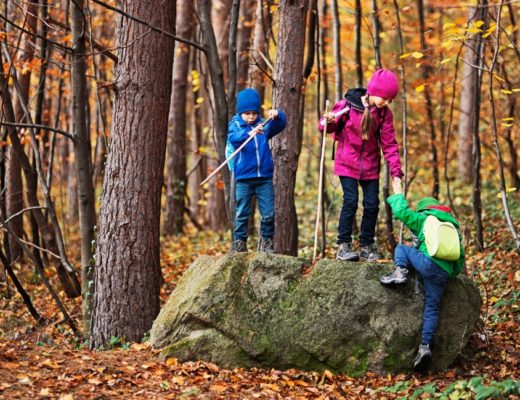Nature offers an expansive playground for kids, fostering curiosity, creativity, and a connection to the environment. Nature activities for kids not only promote physical health but also enhance cognitive and emotional development.
I’m here to share my favorite nature activities for kids, which can transform any outdoor space into a realm of adventure and learning.
- Related: 81 Free Outdoor Activities for Kids
In this post:
We get commissions for purchases made through links in this post. As an Amazon Associate, we earn from qualifying purchases.
The Importance of Nature Activities
Spending time outdoors is essential for all kids (and adults, too)!
Here are some of the benefits of time spent in nature:
- Enhances Physical Health: Running, climbing, and exploring improve cardiovascular health, coordination, and muscle strength.
- Boosts Mental Well-being: Nature reduces stress and anxiety while promoting relaxation and happiness.
- Fosters Creativity: Natural settings stimulate imaginative play and problem-solving skills.
- Promotes Environmental Stewardship: Early exposure to nature fosters a lifelong appreciation and respect for the environment.
Top 29 Nature Activities for Kids
1. Nature Scavenger Hunts
- Age Range: 3-12 years
- Notes: Adapt complexity based on age, with simpler lists for younger kids and more detailed challenges for older ones.
A nature scavenger hunt is a fantastic way to encourage kids to explore their surroundings and can be a great gross motor play activity.
Create a list of items for them to find, such as:
- Different types of leaves
- Various rocks
- Animal tracks
- Flowers
- Insects
You can also find premade free printable nature scavenger hunts.
Provide kids with a small bag to collect their treasures or a camera to capture their finds. Scavenger hunts can be themed around specific topics, like colors, textures, or even seasons.
2. Gardening with Kids
- Age Range: 3-12 years
- Notes: Younger kids can help with planting and watering, while older kids can take on more responsibilities like weeding and planning the garden.
Gardening teaches kids about plant life cycles, responsibility, and the importance of caring for living things. Start with easy-to-grow plants like sunflowers, beans, or herbs.
Allow kids to:
- Dig in the soil
- Plant seeds
- Water the plants
- Pull weeds
Gardening provides hands-on science lessons and a sense of accomplishment when they see their plants grow and thrive.
3. Nature Arts and Crafts
- Age Range: 3-12 years
- Notes: Simple projects like leaf rubbings for younger kids, more complex projects like nature collages for older kids.
Transform natural materials into art projects.
Here are a few ideas:
- Leaf Rubbings: Place a leaf under a piece of paper and rub a crayon over it to reveal its intricate details.
- Rock Painting: Collect smooth stones and paint them with colorful designs.
- Nature Collages: Gather leaves, flowers, twigs, and other natural items to create a collage on paper or canvas.
- Stick Weaving: Use sticks and yarn to weave beautiful patterns.
These activities blend creativity with an appreciation for nature’s beauty.
4. Building Fairy Houses
- Age Range: 3-10 years
- Notes: Engages younger kids’ imaginations with simple construction using natural materials.
Encourage imaginative play by constructing fairy houses in the yard or at a local park. Use natural materials like sticks, leaves, acorns, and moss to build tiny homes for fairies or woodland creatures.
This activity sparks creativity and storytelling as kids invent tales about the inhabitants of their miniature dwellings.
5. Bird Watching
- Age Range: 5-12 years
- Notes: Requires patience and observation skills, which are better developed in school-aged kids.
Bird watching teaches patience and observation skills. Equip kids with binoculars and a bird guidebook. You can often check out a guidebook from you local library.
Visit a local park or nature reserve and try to identify different bird species. Keep a journal to document the birds spotted, noting their colors, behaviors, and habitats.
This activity can also be combined with making bird feeders to attract birds to your yard.
6. Hiking and Nature Walks
- Age Range: 3-12 years
- Notes: Choose trail difficulty based on the child’s age and stamina.
Hiking is a wonderful way to explore the great outdoors. Choose trails that are suitable for kids, with manageable distances and interesting features like streams, rocks, or wildlife.
Encourage kids to:
- Observe different plants and animals
- Listen to nature sounds
- Collect interesting rocks or leaves (if allowed)
- Take photos of their discoveries
Nature walks can be spontaneous or planned, offering opportunities for physical exercise and environmental education.

7. Pond Dipping and Stream Exploration
- Age Range: 5-12 years
- Notes: Requires supervision and some coordination, suitable for school-aged kids.
Exploring ponds and streams reveals a hidden world of aquatic life. Equip kids with nets, buckets, and magnifying glasses to investigate the water.
Look for:
- Tadpoles and frogs
- Fish
- Insects like dragonflies and water striders
- Plants like algae and lily pads
Always supervise kids near water and ensure they understand safety rules.
This activity teaches about ecosystems and the importance of clean water.
8. Camping in the Backyard
- Age Range: 3-12 years
- Notes: Fun for all ages, with activities adapted to the child’s interests and abilities.
You don’t need to venture far to enjoy the joys of camping. Set up a tent in the backyard and spend the night under the stars.
Plan camping activities such as:
- Stargazing: Identify constellations and planets.
- Storytelling: Share stories around a campfire or flashlight.
- Outdoor Cooking: Make s’mores, hot dogs, or other campfire treats.
- Nighttime Nature Walks: Listen for nocturnal animals and observe how the environment changes after dark.
Backyard camping provides a safe and convenient way to experience the magic of the outdoors.
Check out all my favorite headlamps for kids that are perfect for camping!
9. Nature Journaling
- Age Range: 5-12 years
- Notes: Best for school-aged kids who can write or draw independently.
Encourage kids to keep a nature journal where they can document their outdoor adventures.
Provide them with a notebook and art supplies to:
- Draw plants, animals, and landscapes
- Record observations and reflections
- Press flowers and leaves
- Write poems or stories inspired by nature
Nature journaling combines art, writing, and science, fostering a deeper connection to the environment.
10. Building Natural Playgrounds
- Age Range: 3-10 years
- Notes: Suitable for younger kids with adult supervision and assistance.
Create a natural playground using materials found in your yard or local area.
Build structures like:
- Stick forts
- Log balance beams
- Rock climbing areas
- Mud kitchens
These playgrounds encourage unstructured, independent play and physical activity while sparking imagination and creativity.
11. Nature-Themed Games
- Age Range: 3-10 years
- Notes: Games can be easily adapted for different age groups.
Incorporate nature into classic games to make them more engaging.
Some ideas include:
- Nature Bingo: Create bingo cards with pictures of plants, animals, and other natural items. Kids mark off the items as they find them.
- Hide and Seek: Play in a wooded area or park with plenty of hiding spots.
- Tag: Incorporate nature elements like “tree bases” where players are safe.
These games make outdoor play exciting and interactive.
12. Environmental Stewardship Activities
- Age Range: 5-12 years
- Notes: Best for school-aged kids who can understand and participate in organized activities.
Teach kids the importance of caring for the environment with activities like:
- Litter Cleanup: Organize a cleanup day at a local park or beach. Provide gloves and bags, and teach kids about recycling.
- Tree Planting: Participate in a tree-planting event or plant a tree in your yard. Discuss the benefits of trees for the environment.
- Composting: Start a compost bin at home and teach kids about recycling organic waste.
These activities instill a sense of responsibility and environmental stewardship.
13. Outdoor Science Experiments
- Age Range: 5-12 years
- Notes: Activities can be simplified or made more complex based on the child’s age and understanding.
Bring science lessons outdoors with fun experiments such as:
- Weather Station: Set up a simple weather station with a rain gauge, thermometer, and wind vane. Record daily weather observations.
- Solar Oven: Build this simple solar oven using a cardboard box, aluminum foil, and plastic wrap. Use it to cook simple snacks like s’mores or melted cheese.
- Plant Dissection: Examine the parts of a flower or plant under a magnifying glass. Identify the roots, stems, leaves, and flowers.
These experiments make science tangible and engaging.
14. Seasonal Activities
- Age Range: 3-12 years
- Notes: Each season offers different activities that can be tailored to various age groups.
Adapt nature activities to the changing seasons to keep kids engaged year-round:
- Spring: Go on a wildflower walk, look for baby animals, and fly kites.
- Summer: Have a beach day, go bug hunting, and create a backyard water park with sprinklers and water balloons.
- Fall: Collect colorful leaves, visit a pumpkin patch, and make leaf piles for jumping.
- Winter: Build snowmen, go sledding, and look for animal tracks in the snow.
Each season offers unique opportunities for exploration and learning.

15. Storytelling and Reading Outdoors
- Age Range: 3-10 years
- Notes: Suitable for younger kids who enjoy listening to stories and participating in imaginative play.
Combine a love of books with the beauty of nature by setting up an outdoor reading nook.
Bring a blanket and some favorite books to a shady spot in the yard or park. Read stories about nature, animals, and adventures to inspire kids to explore their surroundings.
Encourage them to create their own stories based on their outdoor experiences.
16. Geocaching
- Age Range: 6-12 years
- Notes: Requires basic understanding of GPS and navigation, making it suitable for older kids.
Geocaching is a modern-day treasure hunt using GPS devices. Participants hide and seek containers called “geocaches” or “caches” at specific locations marked by coordinates.
Here’s how to get started:
- Download a Geocaching App: Many free apps are available that show nearby caches.
- Prepare a Geocaching Kit: Include a GPS device or smartphone, a pen for signing logs, and small trinkets for trade.
- Find Caches: Follow the app’s directions to locate caches, sign the logbook, and trade items if desired.
- Hide Your Own Cache: Create and hide a cache for others to find, teaching kids about navigation and cooperation.
Geocaching combines technology with outdoor exploration, making it a hit with tech-savvy kids.
17. Nature Yoga
- Age Range: 3-12 years
- Notes: Simple poses for younger kids, more challenging sequences for older kids.
Introduce kids to yoga in the great outdoors. Practicing yoga outside can enhance the experience by connecting movements to natural elements.
A set of yoga cards can help kids learn poses and create sequences.
Here are some poses to try:
- Tree Pose: Balance on one foot and stretch arms upward, like a tree.
- Downward Dog: Form an inverted V with your body, imitating a playful puppy.
- Butterfly Pose: Sit with feet together and knees out, flapping “wings.”
- Mountain Pose: Stand tall with arms at your sides, grounding like a mountain.
Nature yoga promotes physical fitness, mindfulness, and a deep connection to the environment.
18. Bug Hotels
- Age Range: 5-12 years
- Notes: Building and observing bug hotels can be tailored to different age levels.
Build a bug hotel to attract and observe insects. Bug hotels provide habitats for beneficial insects like bees, ladybugs, and butterflies.
Here’s how to make one:
- Choose a Location: Place the hotel in a sheltered, sunny spot.
- Collect Materials: Use natural materials like sticks, leaves, pine cones, and bamboo.
- Assemble the Hotel: Arrange the materials in layers within a wooden frame or stacked boxes.
- Observe the Guests: Check the bug hotel regularly to see which insects have moved in.
This activity teaches kids about insect habitats and the role of bugs in the ecosystem.
19. Cloud Watching
- Age Range: 3-12 years
- Notes: Simple and relaxing activity suitable for all ages.
Cloud watching encourages relaxation and imagination. Lie on the grass and look up at the sky, observing the different shapes and types of clouds.
Here are some tips:
- Identify Cloud Types: Learn about different clouds, such as cumulus, stratus, and cirrus.
- Make Up Stories: Create stories or identify shapes in the clouds, like animals or objects.
- Track Weather Changes: Observe how clouds change with the weather, predicting rain or clear skies.
Cloud watching helps develop observational skills and provides a peaceful connection to nature.
20. Shell Collecting
- Age Range: 3-12 years
- Notes: Engages all ages, with safety considerations for younger kids.
If you live near the coast, shell collecting is a delightful activity.
Here’s how to make the most of it:
- Visit a Beach: Choose a beach known for its variety of shells.
- Bring a Container: Use a bucket or bag to collect shells.
- Learn About Shells: Identify different types of shells and learn about the creatures that once inhabited them.
- Create Shell Art: Use collected shells to make crafts like shell necklaces, picture frames, or mosaics.
Shell collecting combines exploration with education about marine life.

21. Nature Photography
- Age Range: 6-12 years
- Notes: Older kids can handle cameras or smartphones and understand basic photography concepts.
Introduce kids to photography by capturing the beauty of nature.
Equip them with a camera or smartphone and encourage them to:
- Photograph Plants and Animals: Take close-up shots of flowers, insects, and other wildlife.
- Capture Landscapes: Shoot wide-angle photos of forests, mountains, or water bodies.
- Create a Nature Photo Book: Compile their best photos into a scrapbook or digital album.
- Participate in Photo Contests: Enter local or online nature photography contests.
Nature photography enhances observation skills and fosters a creative appreciation for the environment.
22. Fishing
- Age Range: 6-12 years
- Notes: Requires patience and some skill, suitable for older kids.
Fishing is a classic outdoor activity that teaches patience and provides an opportunity to learn about aquatic ecosystems.
Here’s how to get started:
- Choose a Fishing Spot: Find a local pond, lake, or river with good fishing opportunities.
- Get Basic Equipment: Use a simple rod and reel, bait, and tackle.
- Learn Fishing Techniques: Teach kids how to cast, reel in, and handle fish safely.
- Follow Regulations: Ensure you have the proper fishing licenses and follow local regulations.
Fishing can be a relaxing and rewarding way to connect with nature and family.
23. Tree Identification
- Age Range: 6-12 years
- Notes: Involves observational skills and use of field guides, best for school-aged kids.
Learning to identify trees enhances kids’ knowledge of botany and ecology.
Here’s how to begin:
- Get a Tree Guide: Use a field guide or app to help identify trees.
- Observe Leaves and Bark: Note the shape, size, and texture of leaves and bark.
- Look at Tree Shapes: Identify the overall shape and size of the tree.
- Learn Fun Facts: Teach kids interesting facts about each tree species.
Tree identification can turn any walk in the park into an educational adventure.
24. Outdoor Cooking
- Age Range: 5-12 years
- Notes: Younger kids can assist with simple tasks, while older kids can take on more responsibility.
Outdoor cooking combines the joy of preparing food with the fun of being outside.
Here are some simple ideas:
- Picnics: Pack a healthy picnic and enjoy it in a scenic spot.
- Campfire Cooking: Roast marshmallows, hot dogs, or make foil packet meals.
- Solar Cooking: Use a solar oven to cook simple snacks using the sun’s energy.
- Foraging: Safely forage for edible plants or berries and incorporate them into your meals.
Outdoor cooking teaches kids about food preparation and the importance of sharing meals in nature.
25. Kite Flying
- Age Range: 3-12 years
- Notes: Fun for all ages with kites appropriate for different skill levels.
Kite flying is a delightful way to enjoy windy days.
Here’s how to get started:
- Choose a Kite: Select a kite that suits your child’s age and skill level.
- Find an Open Area: Go to a park, beach, or field with plenty of open space.
- Teach Flying Techniques: Show kids how to launch, steer, and land the kite.
- Have a Kite Decorating Session: Customize plain kites with drawings and decorations.
Flying kites combines physical activity with the joy of watching creations soar.
26. Tracking Wildlife
- Age Range: 6-12 years
- Notes: Requires patience and careful observation, suitable for older kids.
Tracking wildlife is an exciting way to learn about animals and their habitats.
Here’s how to begin:
- Look for Animal Tracks: Identify tracks in mud, sand, or snow.
- Observe Animal Signs: Find signs like feathers, fur, nests, or scat.
- Use a Field Guide: Help identify the tracks and signs you find.
- Be Quiet and Patient: Teach kids to move quietly and observe from a distance.
Wildlife tracking develops patience and observation skills while teaching about local fauna.
27. Nature-Based Storytelling
- Age Range: 3-10 years
- Notes: Younger kids enjoy creating and acting out stories.
Encourage kids to use their imagination by telling stories inspired by nature.
Here’s how:
- Start with a Prompt: Use prompts like “Once upon a time in the forest…” or “On a magical mountain…”.
- Incorporate Nature Elements: Include animals, plants, and natural landscapes in the story.
- Act Out the Story: Use costumes and props to bring the story to life.
- Write and Illustrate: Turn the story into a book with illustrations.
Nature-based storytelling fosters creativity and language skills.
28. Night Sky Observing
- Age Range: 5-12 years
- Notes: Best for school-aged kids who can understand constellations and basic astronomy.
Observing the night sky introduces kids to astronomy and the wonders of the universe.
Here’s how to begin:
- Find a Dark Spot: Go to a location with minimal light pollution.
- Use a Telescope: Enhance the viewing experience with a telescope.
- Identify Constellations: Learn about and identify different constellations and planets using a kid-friendly constellation book.
- Track the Moon: Observe the phases of the moon and discuss lunar facts.
Night sky observing fosters curiosity about space and science.
29. Wilderness Survival Skills
- Age Range: 8-12 years
- Notes: Suitable for older kids who can learn and practice survival skills safely.
Teach kids basic survival skills for a deeper connection to nature.
Here are some skills to cover:
- Building a Shelter: Learn how to construct simple shelters using natural materials.
- Starting a Fire: Safely practice building and lighting a fire.
- Finding Water: Teach ways to find and purify water in the wild.
- Navigating with a Compass: Learn basic compass and map reading skills.
Wilderness survival skills build confidence and self-reliance.

Final Thoughts on Nature Activities for Kids
Nature activities for kids provide endless opportunities for exploration, learning, and fun.
Whether it’s a simple walk in the park, a hands-on science experiment, or an imaginative art project, these activities foster a deep connection to the natural world.
By encouraging kids to engage with nature, we help them develop a lifelong appreciation for the environment and its many benefits.







No Comments